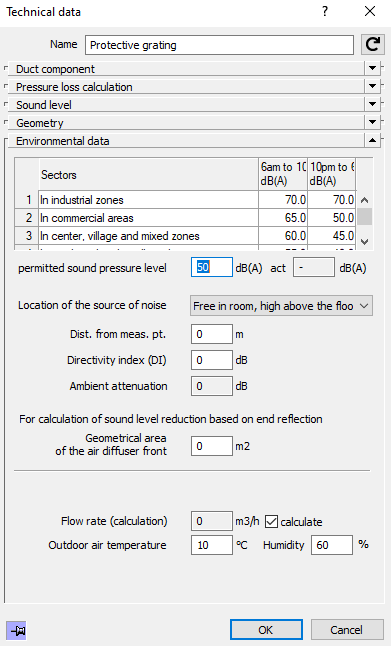Details on Component Data for Protective Grating
Information about the technical data dialog for protective grating.
The protective grating always represents the beginning or the connection of a duct network to the outside, regardless of the flow direction. Although they are also air outlets, they should not be confused with air diffusers, which are installed in rooms for ventilation and are considered accordingly in the context of the calculation.
You are here:

Name
Specifies the name of the component. You can modify the name. Clicking  restores the default setting.
restores the default setting.
Environmental data
Sectors: Select an appropriate sector for your project location from the list. Different limit values are proposed depending on the selected sector.
permitted sound pressure level: The program automatically adopts the lower sound level for the time from 22 up to 6 o'clock. You can adjust this value manually.
permitted sound act.: The limit values for the sound calculation of the protective grating refer to the sound pressure level at the point to be protected (such as a property boundary or a room near the protective grating). The actual sound pressure level is determined from the sound power leaving the protective grating and the propagation of the sound outside. The propagation of sound is influenced by the location of the noise source, the distance to the measurement point and the directivity index.
Location of the source of noise: Describes the position of the protective grating at the building. Depending on the position of the protective grating, the sound propagates spherically or only partially. The smaller the area, the lower the sound reduction.
Distance to measuring point: The distance from the protective grating to the point requiring protection.
Directivity index (DI): The difference in sound level pressure (measured at the point requiring protection) between this protective grating and a non-directional, point source of sound with the same sound power. VDI 2081 provides the following assumptions as a rough guideline: If the protective grating and the point to be protected are on opposite sides of the building, an absorbability of -20 db can be applied. If the point worth protecting is on the same side as the protective grating, the directivity index is equal to 0 db.
Ambient attenuation: Displays the value of the ambient attenuation calculated according to VDI 2081-1. The ambient attenuation is the attenuation that takes place from the protective grating to the measuring point. The value of the ambient attenuation is determined based on the location of the sound source, the distance to the measurement point and the directivity index. The ambient attenuation is subtracted from the residual sound and results in the permissible actual sound level.
For calculation of sound level reduction based on end reflection - Geometrical area of the air diffuser front: The effective discharge area of the protective grating is used to determine the sound level reduction via end reflection at the grille.
Volume flow rate (Dimensioning): After the calculation is complete, the total volume flow of the system is shown here if the Calculate check box is activated.
Output temperature and Humidity Enter the system-specific settings such as outside air temperature and humidity. Default values can be set in the Calculation presettings of the Settings.
Duct component, Pressure loss calculation, Sound level, Geometry
Information on these sections of the component data can be found on the page “Details on duct component, pressure loss calculation, sound level, duct material/insulation and geometry in the components”.